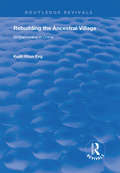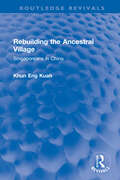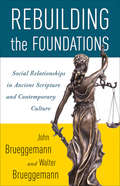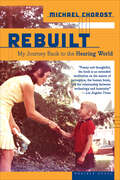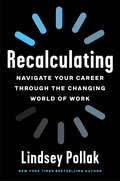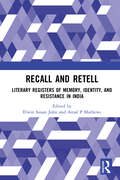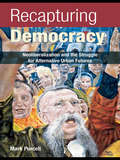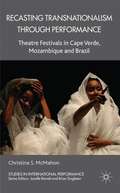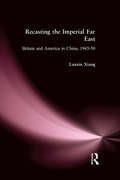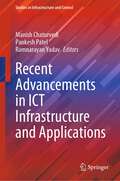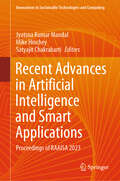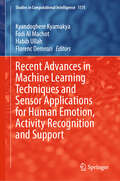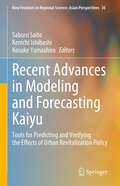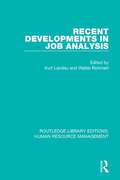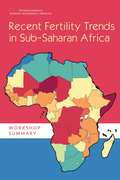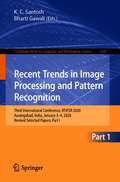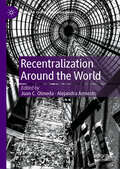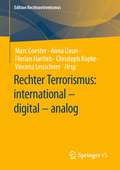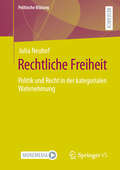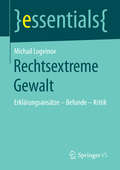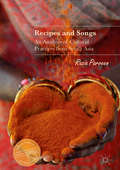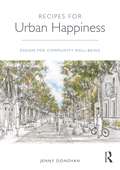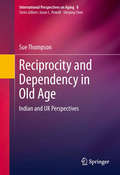- Table View
- List View
Rebuilding the Ancestral Village: Singaporeans in China (Routledge Revivals #Monographs 5)
by Kung Eng KuahThis title was first published in 2000: This is a discussion of the relationship between one group of Singapore Chinese and their ancestral village in Fujian in China. It explores the various reasons why the Singapore Chinese continue to want to maintain ties with their ancestral village and how they go about reproducing Chinese culture (in the form of ancestor worship and religion) in the village milieu in China. It further explores the reasons why the Singapore Chinese feel morally obliged to assist their ancestral village in village reconstruction (providing financial contributions to infrastructure development such as the buildings of roads, bridges, schools, hospitals) and to help with small scale industrial and retail activities. Related to this is how the village cadres and teenagers, through various strategies, managed to encourage the Singapore Chinese to revisit their ancestral village and help with village reconstruction, thereby creating a moral economy. The main argument here concerns the desire of the Singapore Chinese to maintain a cultural identity and lineage continuity with their ancestral home. Ethnographically, this anthropological study examines two groups of Chinese separated by historical and geographical space, and their coming together to re-establish their cultural identity through various cultural and economic activities. At the theoretical level, it seeks to add a new dimension to the study of Chinese transnationalism and diaspora studies.
Rebuilding the Ancestral Village: Singaporeans in China (Routledge Revivals)
by Khun Eng KuahOriginally published in 2000, this second edition was first published in 2010. This is a discussion of the relationship between one group of Singapore Chinese and their ancestral village in Fujian in China. It explores the various reasons why the Singapore Chinese continue to want to maintain ties with their ancestral village and how they go about reproducing Chinese culture (in the form of ancestor worship and religion) in the village milieu in China. It further explores the reasons why the Singapore Chinese feel morally obliged to assist their ancestral village in village reconstruction (providing financial contributions to infrastructure development such as the buildings of roads, bridges, schools, hospitals) and to help with small scale industrial and retail activities. Related to this is how the village cadres and teenagers, through various strategies, managed to encourage the Singapore Chinese to revisit their ancestral village and help with village reconstruction, thereby creating a moral economy. The main argument here concerns the desire of the Singapore Chinese to maintain a cultural identity and lineage continuity with their ancestral home. Ethnographically, this anthropological study examines two groups of Chinese separated by historical and geographical space, and their coming together to re-establish their cultural identity through various cultural and economic activities. At the theoretical level, it seeks to add a new dimension to the study of Chinese transnationalism and diaspora studies.
Rebuilding the Foundations: Social Relationships In Ancient Scripture And Contemporary Culture
by Walter Brueggemann John BrueggemannIn this unique volume, father-and-son team Walter and John Brueggemann take a close look at our fractured American society and suggest ways for improvement. Using six themes identified by some scholars as the moral foundations of society—care, fairness, liberty, loyalty, authority, and sanctity—they examine the unsustainable patterns of our contemporary society and reveal how those patterns played out in the ancient world of the Old Testament. Brueggemann and Brueggemann demonstrate how comparing the current state of these moral foundations with what God wanted them to be can help us better respond to the challenges of today. They assert that achieving any significant change will require the work of all of us and will be grounded in a vision of neighborliness. Rebuilding the Foundations will inspire readers to reorient toward a better way of living, both for themselves and for all living things.
Rebuilt: My Journey Back to the Hearing World
by Michael ChorostAfter Michael Chorost suddenly lost what was left of his hearing, he took the radical step of having a cochlear implant -- a tiny computer -- installed in his head. A technological marvel, the device not only restored to him the world of sound but also could be routinely upgraded with new software. Despite his intitial fear of the technology's potentially dehumanizing effects, Chorost's implant allowed him to connect with others in surprising ways: as a cyborg, he learned about love, joined a writing group, and formed deeper friendships. More profoundly, his perception of the world around him was dramatically altered. Brimming with insight and written with charm and self-deprecating humor, Rebuilt unveils, in personal terms, the astounding possibilities of a new technological age.
Recalculating: Navigate Your Career Through the Changing World of Work
by Lindsey PollakA leading workplace expert provides an inspirational, practical, and forward-looking career playbook for recent grads, career changers, and transitioning professionals looking to thrive in today’s rapidly evolving workplace.Covid-19 has heightened career uncertainty in a work landscape dominated by turbulence and change, and it is directly impacting how people are entering—or re-entering—the workplace. But as Lindsey Pollak makes clear, the pandemic merely accelerated career and hiring trends that have been building. Changes that were once slowly spreading have been rapidly implemented across all industries. This means that the old job hunting and career success rules no longer apply. Job seekers of all generations and skill sets must learn how to thrive in this “new normal,” which will include a hybrid of remote and in-person experiences, increased reliance on virtual communication and automation, constant disruption, and renewed employer emphasis on workers’ health and well-being.While this new world is complicated and constantly evolving, you won’t have to navigate it alone. For twenty years, Pollak has been following the trends and successfully advising young professionals and organizations on workplace success. Now, she guides you through the changes currently happening—and those to come. Combining insights from both experts and professionals across generations, she provides encouraging, strategic, and actionable advice on making lifelong decisions about education; building a resilient personal brand; using virtual communication to remotely interview, network, and work; skilling and reskilling for the future; and maintaining self-care and mental health.Like your personal GPS, Pollak equips you to handle workplace obstacles, helping you see them as challenges to navigate rather than impossible roadblocks. There is no perfect path to a dream career, but with Recalculating you’ll be prepared with the necessary skills and tools to succeed.
Recall and Retell: Literary Registers of Memory, Identity, and Resistance in India
by Elwin Susan JohnThis volume explores the instrumental role played by memory in our daily and collective narratives and the manifold ways in which it can destabilize those prevailing in India. It explores manifestations of memory and postmemory through written narratives, within India’s social, political, and cultural memoryscape. Drawing on archival research, oral history collection, and textual and critical analysis, the book endeavours to reconstruct Indian experiences in all their richness and diversity, while challenging dominant paradigms and expanding the boundaries of collective memory.An important contribution, this book will be of interest to students and scholars of history, memory studies, partition studies, sociology, cultural studies, English literature, decolonization, and South Asian studies.
Recapturing Democracy: Neoliberalization and the Struggle for Alternative Urban Futures
by Mark PurcellRecapturing Democracy is a short yet synoptic introduction to urban democracy in our era of political neoliberalism and economic globalization. Combining an original argument with a number of case studies, Mark Purcell explores the condition of democracy in contemporary Western cities. Whereas many scholars focus on what Purcell calls "procedural democracy" – i.e., electoral politics and access to it – he instead assesses "substantive democracy." By this he means the people’s ability to have some say over issues of social justice, material well being, and economic equality. Neoliberalism, which advocates a diminished role for the state and increasing power for mobile capital, has diminished substantive democracy in recent times, he argues. He looks at case studies where this has occurred and at others that show how neoliberalism can be resisted in the name of substantive democracy. Ultimately, he utilizes Henri Lefebvre’s notion of "the right to the city," which encompasses substantive as well as procedural democracy for ordinary urban citizens.
Recasting Transnationalism through Performance
by Christina S. McmahonThe past two decades have witnessed the emergence of a lively Portuguese-language theatre festival circuit, where Brazilian, Portuguese, and Lusophone African artists come together and jointly negotiate the cultural dynamics of an emerging transnational community grounded in a common language and shared colonial histories. Christina S. McMahon trains a sharp ethnographic eye on African performances staged at these festivals, revealing how festival productions and their aftermath can generate new perspectives on race and gender, colonial trauma, and the economics of cultural globalization. Featuring in-depth analysis of performances and artist interviews from Cape Verde, Angola, Guinea-Bissau, and Mozambique countries with vibrant theatre practices and vexed colonial pasts the book reveals how international festivals can be valuable platforms for new intercultural dialogues and diplomatic possibilities. Recasting Transnationalism through Performance offers a fresh look at the role of theatre in navigating new postcolonial realities. "
Recasting the Imperial Far East: Britain and America in China, 1945-50 (Studies On Modern China)
by Lanxin XiangAttempts to shed new light on the Anglo-American rivalry in China in the period between the defeat of Japan and the triumph of the Chinese Communists. This study contends that the USSR was not a major factor in the dispute.
Recent Advancements in ICT Infrastructure and Applications (Studies in Infrastructure and Control)
by Manish Chaturvedi Pankesh Patel Ramnarayan YadavThis book covers complete spectrum of the ICT infrastructure elements required to design, develop and deploy the ICT applications at large scale. Considering the focus of governments worldwide to develop smart cities with zero environmental footprint, the book is timely and enlightens the way forward to achieve the goal by addressing the technological aspects. In particular, the book provides an in depth discussion of the sensing infrastructure, communication protocols, computation frameworks, storage architectures, software frameworks, and data analytics. The book also presents the ICT application-related case studies in the domain of transportation, health care, energy, and disaster management, to name a few. The book is used as a reference for design, development, and large-scale deployment of ICT applications by practitioners, professionals, government officials, and engineering students.
Recent Advances in Artificial Intelligence and Smart Applications: Proceedings of RAAISA 2023 (Innovations in Sustainable Technologies and Computing)
by Mike Hinchey Jyotsna Kumar Mandal Satyajit ChakrabartiThe book includes original unpublished contributions presented in First International Conference on Recent Advances in Artificial Intelligence and Smart Applications (RAAISA 2023), organized by Department of CSE, University of Engineering and Management, Kolkata, India during 14 – 15 December 2023. The topics covered are progression of artificial intelligence techniques like smart agent-based systems, human-computer interaction technologies, reinforcement learning, sentiment analysis, recurrent neural networks and its applications, genetic algorithm, and neural networks.
Recent Advances in Machine Learning Techniques and Sensor Applications for Human Emotion, Activity Recognition and Support (Studies in Computational Intelligence #1175)
by Kyandoghere Kyamakya Fadi Al Machot Habib Ullah Florenc DemroziThis book explores integrating machine learning techniques and sensor applications for human emotion and activity recognition, creating personalized and effective support systems. It covers state-of-the-art machine learning techniques and large language models using multimodal sensors. Enhancing the quality of life for individuals with special needs, particularly the elderly, is a key focus in Active and Assisted Living (AAL) research. Unlike other literature, it emphasizes support mechanisms along with recognition, using metamodel integration for adaptable AAL systems. This book offers insights into technologies transforming AAL for researchers, students, and practitioners. It is a valuable resource for developing responsive and personalized support systems that enhance life quality in smart environments. It is also essential for advancing the understanding of machine learning and sensor technologies in AAL and emotion recognition.
Recent Advances in Modeling and Forecasting Kaiyu: Tools for Predicting and Verifying the Effects of Urban Revitalization Policy (New Frontiers in Regional Science: Asian Perspectives #36)
by Saburo Saito Kosuke Yamashiro Kenichi IshibashiThis book is the first comprehensive presentation of a Kaiyu Markov model with covariates and a multivariate Poisson model with competitive destinations. These two models are core techniques when the authors and colleagues conduct their Kaiyu studies. The two models are usually used to forecast the effects of specific urban redevelopment on both the number of visitors and consumer shop-around or Kaiyu movements. Their Kaiyu studies originated from the constructions of a Kaiyu Markov model and the disaggregated hierarchical decision Huff model almost simultaneously around the early 1980s. This book retrospectively reviews how these models have evolved from the start to the present state, and previews the ongoing efforts to make further extensions of these models. The extension of the Huff model started from the disaggregated hierarchical decision Huff model with shop-arounds. In retrospect, the model formulated the consumer’s simultaneous choice of destinations as a joint probability. The mechanism to determine this joint probability was a recursive conditional probability system. Now the Huff model has shifted from joint probability to multivariate frequency Poisson with competitive destinations. On the other hand, the Kaiyu Markov model started from a descriptive model. Because it cannot forecast changes in shop-arounds or consumer Kaiyu behaviors, the Kaiyu Markov model with covariates was developed in which entrance and shop-around choice probabilities are explained by the respective two logit models with covariates such as distances and shop-floor areas. The noticeable point is that it can explain consumers’ probability of quitting their shop-arounds. Thus, the model enables one to evaluate the effects of urban revitalization policy that promotes consumers’ shop-arounds or Kaiyu behaviors. Furthermore, if the Kaiyu Markov model can estimate the actual numbers of flows of consumers’ shop-arounds among shopping sites, the corresponding money flows also can be estimated as economic effects. This book discusses from scratch the evolution of all these topics. Thus this book provides the basics of the Kaiyu Markov model, a tutorial for the theory and estimation of the conditional logit model, and a chapter serving as a practical research manual for forecasting changes caused by urban development based on consumers’ Kaiyu behaviors.
Recent Developments in Job Analysis (Routledge Library Editions: Human Resource Management)
by Kurt Landau Walter RohmertThe analysis of the various components of human work is the most important approach to a systematic study of people at work. This approach is aimed at the examination of individual activities with respect to the role they play in the conflict of humanitarian, economic, and technical aspects of work. The main objective of this title, which was first published in 1989, was to bring together researchers and practitioners from industry and academia who were interested in ergonomics and psychological aspects of job analysis. This title will be of particular interest to students of human resource management.
Recent Fertility Trends in Sub-Saharan Africa: Workshop Summary
by Engineering Medicine National Academies of SciencesFertility rates and population growth influence economic development. The marked declines in fertility seen in some developing nations have been accompanied by slowing population growth, which in turn provided a window of opportunity for rapid economic growth. For many sub-Saharan African nations, this window has not yet opened because fertility rates have not declined as rapidly there as elsewhere. Fertility rates in many sub-Saharan African countries are high: the total rate for the region is estimated to be 5.1 births per woman, and rates that had begun to decline in many countries in the region have stalled. High rates of fertility in these countries are likely to contribute to continued rapid population growth: the United Nations projects that the region's population will increase by 1.2 billion by 2050, the highest growth among the regions for which there are projections. In June 2015, the Committee on Population organized a workshop to explore fertility trends and the factors that have influenced them. The workshop committee was asked to explore history and trends related to fertility, proximate determinants and other influences, the status and impact of family planning programs, and prospects for further reducing fertility rates. This study will help donors, researchers, and policy makers better understand the factors that may explain the slow pace of fertility decline in this region, and develop methods to improve family planning in sub-Saharan Africa.
Recent Trends in Image Processing and Pattern Recognition: Third International Conference, RTIP2R 2020, Aurangabad, India, January 3–4, 2020, Revised Selected Papers, Part I (Communications in Computer and Information Science #1380)
by K. C. Santosh Bharti GawaliThis two-volume set constitutes the refereed proceedings of the Third International Conference on Recent Trends in Image Processing and Pattern Recognition (RTIP2R) 2020, held in Aurangabad, India, in January 2020.The 78 revised full papers presented were carefully reviewed and selected from 329 submissions. The papers are organized in topical sections in the two volumes. Part I: Computer vision and applications; Data science and machine learning; Document understanding and Recognition. Part II: Healthcare informatics and medical imaging; Image analysis and recognition; Signal processing and pattern recognition; Image and signal processing in Agriculture.
Recentralization Around the World (Executive Politics and Governance)
by Juan C. Olmeda Alejandra ArmestoThe 1990s witnessed a surge in decentralization, as national governments around the world sought to transfer responsibilities and prerogatives to regional and local authorities. The last two decades have seen a reversal of this trend, as national authorities have attempted to regain control over these decentralized tasks in a process known as recentralization. This book is one of the first studies to examine the process of recentralization in a global context. Drawing on country case studies from around the world, including both developed and developing countries, and democratic and authoritarian regimes, the book assesses where and why recentralization has taken place, and what has contributed to its successes and failures. It also examines recentralization in key policy areas, including education policy, health policy and environmental policy. The overall aim is to provide readers with a conceptual and theoretical understanding of recentralization and its consequences, as well as a comparative global overview of common trends and key distinctions at national and regional level. The book will appeal to all those interested in public administration, comparative politics, political science and sociology.
Rechte Akteure im Betrieb: Sechs EU-Länder im Vergleich
by Samuel Greef Wolfgang Schroeder Seongcheol KimDieses Buch ist die erste vergleichende Studie über rechte Kommunikations- und Organisierungsbestrebungen auf betrieblicher Ebene sowie gewerkschaftliche Gegenreaktionen. Im Rahmen eines europäischen Sechs-Länder-Vergleichs (Belgien, Deutschland, Frankreich, Italien, Polen, Ungarn), der auch eine Betriebsfallstudie für jedes Land umfasst, wird eine Klassifikation rechter Aktivitäten und gewerkschaftlicher Reaktionen herausgearbeitet. Der Band beruht auf einem in Zusammenarbeit mit Gewerkschaften durchgeführten Forschungsprojekt und damit auf einem Theorie-Praxis-Dialog zu diesem hochaktuellen Thema.
Rechter Terrorismus: international – digital – analog (Edition Rechtsextremismus)
by Anna Daun Florian Hartleb Marc Coester Christoph Kopke Vincenz LeuschnerIn westlichen Demokratien häufen sich Fälle von rechtem Terrorismus. Die innere Sicherheit und das Leben von gesellschaftlichen Minderheiten und in der Öffentlichkeit stehenden Personen werden durch vielfältige Formen schwerer Gewalttaten und Terrorakte bedroht. Begründungen für solche Akte verweisen auf althergebrachten Rechtsextremismus, Rassismus, Antisemitismus oder Autoritarismus. Ebenso zeigen sich aber auch neue Erscheinungsformen, die auf Verschwörungstheorien und Ideologieversatzstücken aufbauen. Der Band setzt sich zum Ziel, zur Erforschung des gegenwärtigen Rechtsterrorismus beizutragen. Ausgangspunkt ist die Frage, inwieweit es sich bei aktuellen, nationalen und internationalen Attentaten um „neue“ Formen des Terrorismus handelt. Dabei sollen zum einen die weltanschaulichen, strategischen, kommunikativen, praktischen und operativen Dimensionen des Terrorismus beleuchtet werden. Zum anderen soll auch gefragt werden, ob und auf welche Weise diese Erscheinungen mit trans- und internationalen politischen und gesamtgesellschaftlichen Entwicklungen zusammenhängen. Darüber hinaus stellt sich die Frage, welchen Einfluss ein gesellschaftlicher Rechtsruck mit entsprechenden menschenfeindlichen Einstellungen in der Bevölkerung und abwertender Hassrede im Internet auf dieses Phänomen hat. Insgesamt scheinen die neuen, neu konfigurierten oder modifizierten Formen rechten Terrorismus viel mit einem veränderten Verhältnis zwischen Individuum und Kollektiv, zwischen Einzeltäter und globalem Netzwerk zu tun zu haben.
Rechtliche Freiheit: Politik und Recht in der kategorialen Wahrnehmung (Politische Bildung)
by Julia NeuhofJulia Neuhof zeigt, dass Komplexität und Unübersichtlichkeit politisch-rechtlicher Entwicklungen in der modernen Gesellschaft über eine kategorial orientierte politische Bildung vermittelbar sein können. Die Voraussetzungen hierfür werden in einer qualitativen Studie zu der Wahrnehmung rechtlicher Freiheit mit Schülerinnen erfasst. So existieren thematisch vielfältige Kategorisierungen der Lernenden. Für diese lassen sich auf dem politikdidaktisch tradierten Weg kategorialer Bildung Anschlüsse an sozialwissenschaftliche Begriffe zur Deutung politisch-rechtlicher Realität schaffen. Darüber hinaus bestehen jedoch Wahrnehmungshindernisse in der kategorialen Erschließung, die neue politikdidaktische Lehr-Lern-Strategien erforderlich machen. Wie diese aussehen können, wird von der Autorin im Kontext politisch-rechtlichen Lernens vorgeschlagen.
Rechtsextreme Gewalt: Erklärungsansätze – Befunde – Kritik (essentials)
by Michail LogvinovVor dem Hintergrund steigender rechtsextremer Gewalt widmet sich dieses essential der Frage, welche Erkl#65533;rungsans#65533;tze die Rechtsextremismusforschung f#65533;r die rechte Gewaltkriminalit#65533;t erarbeitet hat. Michail Logvinov diskutiert die in den soziologischen Forschungen verbreiteten Interpretationen der Radikalisierungsprozesse im rechten Milieu und arbeitet ihre St#65533;rken und Schw#65533;chen heraus. Er bietet Definitionen der relevanten Gewaltbegriffe und Informationen zur Rolle des Kampfes als Denkfigur und Deutungsmuster im Rechtsextremismus.
Rechtsextremismus, Demokratiebildung, gesellschaftliche Integration: Interdisziplinäre Debatten und Forschungsbilanzen
by Danny Michelsen Andreas BeelmannDer Band präsentiert aktuelle Forschungsergebnisse des Zentrums für Rechtsextremismusforschung, Demokratiebildung und gesellschaftliche Integration (KomRex) der Friedrich-Schiller-Universität Jena. Im ersten Teil werden neben Analysen zum Thema Rechtsextremismus und Radikalisierung aktuelle Befunde der politischen Einstellungsforschung vorgestellt, die u. a. auf Daten des jährlich durchgeführten Thüringen-Monitors basieren. Der zweite Teil fragt nach Grundlagen für eine zeitgemäße Demokratiepädagogik und Extremismusprävention sowie nach den Voraussetzungen für eine erfolgreiche Integration von Migrant*innen.
Recipes and Songs
by Razia ParveenThis book presents a systematic approach to the literary analysis of cultural practices. Based on a postcolonial framework of diaspora, the book utilizes literary theory to investigate cultural phenomena such as food preparation and song. Razia Parveen explores various diverse themes, including the female voice, genealogy, space, time, and diaspora, and applies them to the analysis of community identity. This volume also demonstrates how a literary analysis of oral texts helps to provide insight into women's lived narratives. For example, Parveen discusses how the notion of the 'third space' creates a distinctly feminine spatiality.
Recipes for Urban Happiness: Design for Community Well-being
by Jenny DonovanThe experiences we enjoy, endure, or miss out on are influenced by what our surroundings allow and invite us to do. Just like our food diet, our experience diet influences our health and so our chances of finding happiness and fulfilling our potential. A healthy experience diet offers inspiration, reassurance, delight, and play. It nurtures physical, cognitive, and emotional health, builds resilience, and fosters confidence and self-esteem. An unhealthy experience diet lacks these things and consigns people to lives diminished in quantity and quality. Recipes for Urban Happiness offers an innovative way of looking at the relationship between people and place and redefines what good urban design is. The book outlines what designers and non-designers can do to create urban places where nurturing behaviours are both possible and preferable. Recipes for Urban Happiness will be relevant to public health, community development, and design practitioners, as well as students and academics.
Reciprocity and Dependency in Old Age
by Sue ThompsonThis book highlights (1) the significance of reciprocity for the maintenance of self-esteem in old age and (2) the negative implications for the well-being of dependent older people when that significance goes unrecognized and, as a consequence, opportunities to give back to society, as well as take from it, are not facilitated by those in a position to do so. The discussion draws on research undertaken in the UK and Southern India into the extent to which having the self-perception of being valued in the world is important to older people in receipt of care support and whether, in their experience, this is recognized by others. The author presents an analysis of theoretical insights from leading thinkers across a broad range of literature and from several disciplines, including social theory, social work, philosophy, and gerontology. The author also gives voice to the perspectives of those dependent older people not often heard because of marginalizing and disempowering processes that contribute to their having little opportunity to be heard in the first place. The emphasis of this book is on aspiration to a meaningful life and continuing personal growth as offering a challenge to dominant discourses the equate old age with decline.
